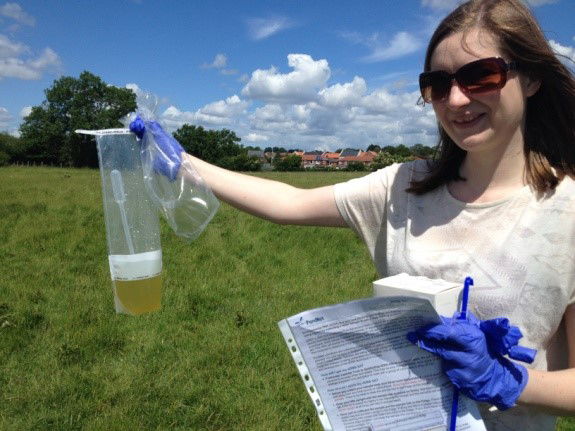The eDNA results are in
24th November 2015
This spring and summer part of the PondNet team, comprising 112 volunteers plus staff, undertook an exciting new survey: an assessment of the status of England’s Great Crested Newt (GCN) population using environmental DNA (eDNA).
 We have developed and trialed the GCN eDNA survey method with the SpyGen laboratory, Amphibian and Reptile Conservation and the Durrell Institute of Conservation and Ecology, over the last few years. This year, thanks to funding from Natural England and our Heritage Lottery Funded People Ponds and Water project, we rolled it out in the first ever national eDNA survey WORLDWIDE!
We have developed and trialed the GCN eDNA survey method with the SpyGen laboratory, Amphibian and Reptile Conservation and the Durrell Institute of Conservation and Ecology, over the last few years. This year, thanks to funding from Natural England and our Heritage Lottery Funded People Ponds and Water project, we rolled it out in the first ever national eDNA survey WORLDWIDE!
Now the results are in, we can tell you that:
- PondNet volunteers are awesome and visited 316 ponds in 100 1km squares to collect 272 eDNA samples.
- We found GCNs in a quarter of the 50 squares where there were previously no records for them.
- We found GCNs at sites where traditional survey methods would be unlikely to find them, showing how valuable this new technique is when trying to find presence/absence in hard to reach sites.
- We’ve provided site managers with useful information about the status of the newts on their sites.
- We didn’t find evidence of GCNs at 16 of the 50 squares where they have been recorded previously. At some sites this appears to indicate a genuine absence, because we’ve had reports that the condition of the pond has declined significantly since the newts were last recorded.
- We’ve learnt more about the percentage of ponds used by GCNs in a given square: the newts rarely occupy all the ponds in a square.
- We are excited (and relieved!) to have a high quality national dataset on GCN occupancy. This is year one and we’re looking forward to gathering data in subsequent years to show how the population is changing.
- Feedback from volunteers has been overwhelmingly positive. People enjoyed taking part because it’s simple, it’s an exciting new technique, and they felt they were doing ‘real’ science. They were!
- We are phenomenally proud of our team, both volunteers and staff, for their commitment, enthusiasm, and all-round greatness.
Next steps
We are really pleased with the results, and how the survey ran. There are, of course, things we want to tweak, and things we want to understand better, and that’s what we want to work on next, with the hope that this can become an annual survey and make a real difference for the conservation of Great Crested Newts.
Want to know more?
- Find out more about PondNet and how you can take part in future eDNA and pond surveys.
- Read more about the research we did to develop the eDNA survey method.
